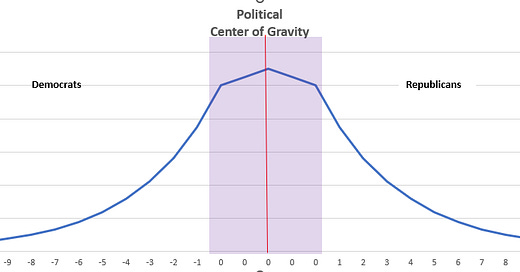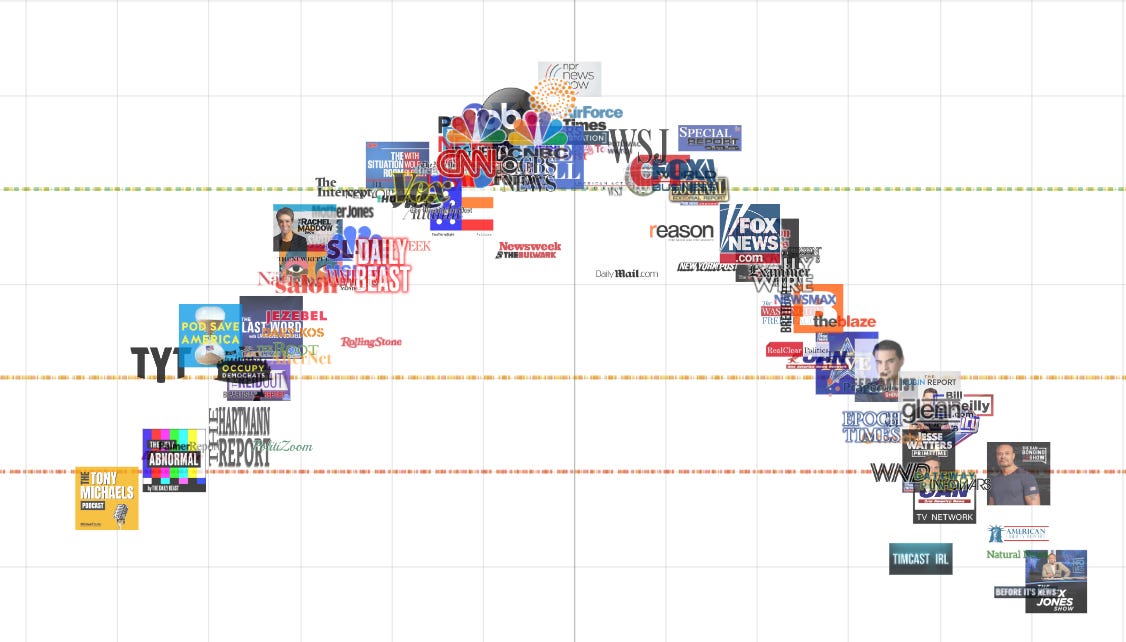The Political Center of Gravity
Idealogues Don't Care About it; Practical Politicians Do. That's Why it's Important to Consider It To Win Elections; Plus, No Labels' Only Real Chance
Imagine if you will a bell curve much like the one above1 Republicans occupy in this country a large swath of the right, Democrats the left. The further away from the middle you go, the less votes there are. 50%+1 is signified by the red line, marking the point at which a majority occurs. The purple area above marks roughly the swing votes that usually result in moving an election one way or the other. Pretty basic, I admit, but for our purposes of discussion, it’ll be fine.
Now, it makes sense if you are a politician, to stake out places close to the middle, as that is where the votes are to win and where most people are. However, the loudest people are not in the middle, they’re on the ends in the fringes. Social Media has only amplified their soapboxes. That brings each party’s political center of gravity outward. All things being equal, it looks a little more like this:
But things are not equal. Partisan media coverage can skew the strength of the fringes. For instance, the below chart shows media bias. Now, there are actually very few within the narrow tint of the “mainsteam” in the chart. As you get further away from center (and even those can be biased), pretty much below that highest dotted line, you are already out in fringe country. Those media outlets scream and yell to pull further apart, not bring together in the middle.
Negative partisanship can make that purple range even thinner. Primary candidates can swing the party COG closer to the middle or the fringe depending on message and success. Plus over time, the Political Center of Gravity changes; what was once liberal or conservative becomes the norm and the electorate shifts accordingly.2
The Political Center of Gravity Over Time
By the 60’s, liberalism, was at it’s peak. Kennedy launched the New Frontier. The Cuba Missile Crisis and Kennedy Assassination underscored what a dangerous time it was, and how important it was for security. Goldwater was out of the mainstream, and as such, people steered clear of the GOP.
The 1964 sweep of Goldwater had shifted the Center of Gravity decidedly in its’ favor, allowing it to appeal further to the left with The Great Society and Civil Rights. Politically, this would prove devastating over the next couple decades as Republicans shifted to the center with more welcoming, acceptable candidates (even shifting to the middle) and the Democrats remained liberal. By 1984, the positions had reversed. Mondale wasn’t even nearly as liberal as Goldwater was Conservative; it’s just that with Reagan’s populism/nationalism, a booming economy and unifying rhetoric, the center of gravity decidedly shifted to the Right. So much so that he was only a few thousand votes in Minnesota short of a 50 state clean sweep.
And it largely stayed like this until the 2000 election when the narrowest and most balanced election ever occured. The parties had nominated the two most electable candidates, both from the general American mainstream politically (both were political legacies) and they were fighting for what would ultimately be the Center of Gravity for the next 20 years. This election would institutionalize the red state/blue state breakdown and create bulwarks on each side that harden; the “blue wall,” the “deep red south” the “purple swings.” Very little changes election to election and the number of states in play narrowed.
Although the election was close, come 9/11 the Center of Gravity shifted hard right. By the time the 2004 election came along, it was receding back to its normal position but was still far enough towards W and the GOP to give him the win.
But the two most impactful elections on the current center of gravity are the 2016 GOP primary and the 2020 Democratic Primary.
In 2016, you had a broad swath of GOP candidates. Republicans chose the one furthest to the right of the mainstream. Hillary, who already had liberal bona fides, campaigned more as a moderate, purposefully pushing her experience as Secretary of State and as a Senator; this was also to contrast with the attack on her left from avowed Socialist Bernie Sanders, who made Hillary look even more mainstream and moderate. It was a huge gamble for Republicans; the size of the swath of the electorate they had to appeal to after the primaries was much larger than what Hillary had to. In addition, many of the swing voters abhorred Trump as a candidate. Nonetheless, he got enough votes in enough states to pull it off. 3
In 2020, Democrats at first looked like they were going to do the same thing in reverse. The big names early were hardcore liberals Elizabeth Warren, Bernie Sanders, Kamala Harris and even Pete Buttigieg. Joe Biden’s campaign looked dead on arrival. But ultimately, they aligned with Biden as their standard bearer. In addition, voters had seen a Trump Presidency and were now averse to it in a big way; the political center of gravity shifted to the left. Biden was able to do what Hillary wasn’t and win the White House.
Where Are We Now?
Biden has governed by focusing on solid mainstream issues while occasionally throwing red meat to the liberals. Add onto that some really horrific Supreme Court Decisions and his base is fired up and he can focus on further shifting that center of gravity.
On the right, its extremely odd. Trump has continued to stake a place further right, bringing more of the candidates with him. The only real exception you could make is Chris Christie who is specifically running vrs. Trump as opposed to the others, but that remains to be seen how successful it will be. None of them have worked to grow any major following and Trump has secured about 50% of the GOP voters before the voting even begins. I’d say it looks a lot like this:
If Trump’s primary success becomes inevitable, look for Biden to start to work harder bringing those swing states into the fold, pressing his advantage on the GOP side of the line. The more he can bring those states into his column, the bigger his Electoral Vote victory in November 2024 will be.
Why No Labels Will Fail; Or Maybe Not
No Labels cites an historically low approval rating of both major parties to justify the need for a center based third party bid.
Take a look at the chart above. What does it tell you?
What it tells me is that Biden has already staked out a nice area close to the center. You may say, “Well why doesn’t his numbers look better then?” Its because of two reasons really: 1) his age gives voters pause and 2) LIBERALS are upset at him for not being MORE Liberal. For now, they’re crying and whining because that’s what fringes do when they don’t get their way, but when it becomes a dichotomous choice, they almost always fall in line. Come March, you can expect Biden to see his poll numbers spike upward barring an intervening event.
But there is room on the moderate right for a 3rd party candidate. That’s not normal, as its usually occupied by the consensus Republican candidate. Instead, Trump is wide right. That’s because Trump has always behaved as a 3rd Party candidate. He instead ran within the GOP and pulled the GOP along with him. However, the GOP has a brand that is largely inelastic; GOP voters will stick with the GOP candidate even if he leads them off a cliff. There are a solid 40% of the overall eletorate with Trump.
That leaves about 10% for No Labels to really work with. Who are these 10%? Never Trump Republicans mostly. They hate Trump, are OK with Biden (although they hate the liberals of the Democratic party), and recognize the danger Trump poses to the country should he win election again. In that instance, they won’t pull the lever for a 3rd Party (as much as they may throw it out there as an option), but will fall in line with Biden when the time comes.
Which brings up the one occassion where it might work, and its similar to the 2016 election, when going into Election Day, Hillary looked all but assured of winning. What happened? A large contingent voted for Trump because they never thought Trump would win. Hillary was ahead by enough to coast and, unfortunately for her, this protest vote was big enough to swing it for Trump.
There’s a hole in the electorate that says “I’m a Republican, I hate Trump, but I dislike Democrats and Biden is ahead by enough where my vote won’t matter.” How big is that hole? Who knows. But that’s the only range where No Labels can play a role; and if it is in the right places and results in a big enough margin, it can be enough.
So paradoxically, the further Biden pulls out ahead, the greater the chances No Labels can play spoiler in the election.
Like what you are seeing here at PurpleAmerica? Share and Comment. Let your friends and family know! Forward us topics you’d like us to discuss! It’s am open community here.
Footnotes and Fun Stuff
Yes, I am aware this is not a perfect bell curve. I’m strapped for time and don’t have too much time to spend on making the curve perfect. Sue me. It’ll work for the presentation I have in this post.
An example of this are social security, which is a very liberal program but with adoption and normalization is squarely in the center of gravity.
This should underscore what a historically BAD candidate Hillary Clinton was. Although she appeals to Democrats, she was largely toxic to a wide range of voters in the middle. Had she just a little more appeal in a few states, Trump would not have become President.














This article presents graphically the fundamental misunderstanding about our politics. It shows generic Democrats as solidly to the left of the median political center, with the generic Republicans a comparable degree to the right. This is flat out wrong. The Democratic Party of today, as exemplified by the policies of the Biden administration, espouse and practice policies on key issues that have the support of solid majorities of voters. Yes, it has the odd solidly left-of-center Congress members, but they do NOT exercise any real control of the Party. Conversely, today's Republican Party, both its officeholders and its primary voters, exercise total dominance of the GOP. Kevin McCarthy must bow to the demands of Marjorie Taylor Greene. Whereas Hakeem Jeffries either persuades his most liberal members to vote with the majority of his party OR they become part of a tiny minority on the losing end of a vote. Still more important, the views of the most progressive Democratic officeholders on such issues as abortion, the Green New Deal or Medicare for All have, by and large, majority support among the general voting public, not just Democrats. The views of the dominant far-right Republicans on those issues are rejected by solid majorities of American voters, not just self-declared Democrats. It is seriously misguided to present BOTH parties as equally removed from the supposed political median, as this article does.